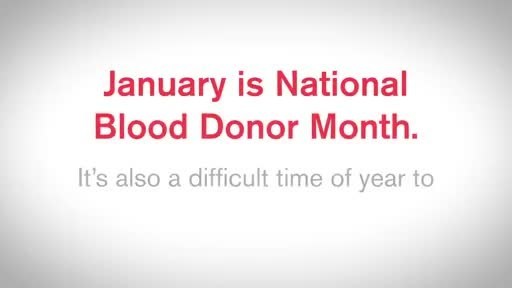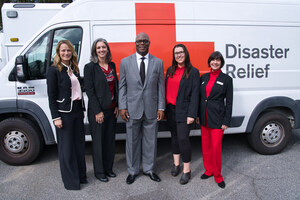WASHINGTON, Jan. 14, 2019 /PRNewswire/ -- The American Red Cross issued an emergency call today for blood and platelet donors to give now and help mitigate a blood shortage. With holiday scheduling keeping donors busy, the Red Cross collected about 27,000 fewer blood and platelet donations during the weeks of Christmas and New Year's than needed.
Right now, the Red Cross is urging people across the country, especially type O, to schedule an appointment to give. Eligible individuals can make a donation appointment by simply downloading the free American Red Cross Blood Donor App, visiting RedCrossBlood.org or calling 1-800-RED CROSS (1-800-733-2767).
January is National Blood Donor Month, a time to celebrate generous volunteer donors and raise awareness for the need for blood donations. It is also a month often plagued by snowstorms and seasonal illness that result in low donor turnout at blood drives and force many to delay giving, and this year is no different. This past weekend, blood drives were canceled in several states from the Midwest to the East Coast due to Winter Storm Gia, contributing to already low inventory levels. In addition, the Centers for Disease Control (CDC) reports wide spread influenza across nearly half the country and cases of the flu occurring in nearly all 50 states.
"During the winter months, snow storms, icy road conditions and seasonal illness like the flu often cause blood donors to delay their donations," said Chris Hrouda, president, Red Cross Blood Services. "This further exasperates our already depleted blood supply from over the holidays. We are working every day to restock hospitals shelves with lifesaving blood products for patients and right now, we need all healthy, eligible individuals to give blood and platelets as soon as possible to ensure we can meet patient needs."
The Red Cross encourages eligible individuals to review tips for blood donation during flu season.
Resolve to help patients like Luna all year long
At the young age of one and half years-old, Luna Giles is already a princess warrior. In her first year of life, she had two heart surgeries that required over a dozen blood transfusions. Luna will likely need more blood products for an additional surgery in her future.
"Each time, the nurse would bring in a bag of blood for her transfusion, I noticed a small label on each one that said, 'Donation Type: Volunteer,'" said Jessie Giles, Luna's mother. "It made me think about each individual who donated blood for my daughter. I would never know who those individuals were, and they would never see the effect their donation had. But each of those individuals, strangers to us, absolutely saved my daughter's life. They may never know it, but to me, they are heroes."
To pay it forward, the Giles family holds blood drives in the community in honor of Luna and other patients.
"Luna's story is a reminder of the constant need for blood. People would ask me how they could help and I would tell them to go give blood."
Luna is not alone in her need for lifesaving blood products. Patients rely on blood and platelets every day for accident and burn victims, heart surgery and organ transplant patients, and those receiving treatment for leukemia, cancer or sickle cell disease. Blood products are perishable, and the only source of lifesaving blood for patients is volunteer blood donors.
Prepare for your blood donation appointment
A blood donor card or driver's license, or two other forms of identification are required at check-in. Individuals who are 17 years of age in most states (16 with parental consent where allowed by state law), weigh at least 110 pounds and are in generally good health may be eligible to donate blood. High school students and other donors 18 years of age and younger also have to meet certain height and weight requirements.
Blood and platelet donors can save time at their next donation by using RapidPass® to complete their pre-donation reading and health history questionnaire online, on the day of their donation, before arriving at the blood drive. To get started, follow the instructions at RedCrossBlood.org/RapidPass or use the Blood Donor App.
Donors can help even more people by inviting a family member, friend or co-worker to donate too.
Host a blood drive in the community
During the weeks of Christmas and New Year's, about 1,350 fewer blood drives were also hosted by volunteer sponsor groups than required to meet patient needs. With more than 80 percent of blood donations made at blood drives organized by volunteer sponsor groups and coordinators, more hosts are needed to hold blood drives in the months ahead.
To learn more about hosting a blood drive and to sign up to sponsor a drive this winter, visit RedCrossBlood.org/HostADrive.
About the American Red Cross:
The American Red Cross shelters, feeds and provides emotional support to victims of disasters; supplies about 40 percent of the nation's blood; teaches skills that save lives; provides international humanitarian aid; and supports military members and their families. The Red Cross is a not-for-profit organization that depends on volunteers and the generosity of the American public to perform its mission. For more information, please visit redcross.org or cruzrojaamericana.org, or visit us on Twitter at @RedCross.
SOURCE American Red Cross
Related Links
WANT YOUR COMPANY'S NEWS FEATURED ON PRNEWSWIRE.COM?
Newsrooms &
Influencers
Digital Media
Outlets
Journalists
Opted In






Share this article